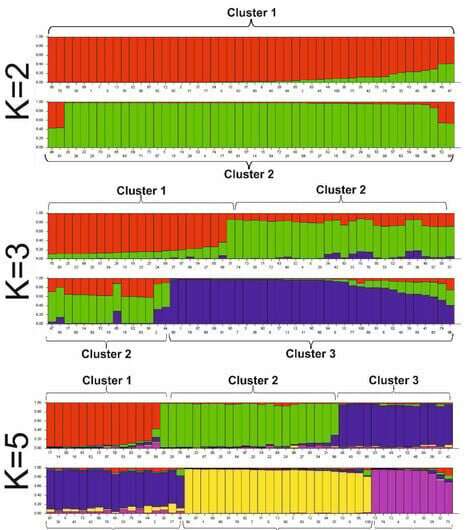Results of population structure analysis of 100 millet accessions: cluster plots at K = 2, K = 3 and K = 5. Image Source: agronomy (2023). DOI: 10.3390/Agriculture13102514
Compared with other cereals, millet (Panicum miliaceum L) has the important advantage of being resistant to drier climates. Millet contains all the amino acids necessary for the human body, and 10% to 15% of its ingredients are protein. However, millet, for example, has lower yields than wheat. Therefore, it is planted less frequently and does not reach its full potential.
For the same reason, this plant is one of the least studied crops from a genetic perspective. At the same time, knowledge about millet’s genetic diversity will help grow it more efficiently. To this end, agronomists from the People’s Friendship University of Russia have drawn a complete genetic “map” of millet.
“Millet is an important food crop. However, it is also the least studied cereal type simply because it is not grown much. The genomic base of millet is very limited compared to major crops. However, understanding the genetic relationships is very difficult. Simple, because it is not cultivated much. The genomic base of millet is very limited compared to major crops. However, it is important to understand the genetic relationships “for future breeding,” says Meisam Zargar, Ph.D. in Agricultural Sciences, associate professor at the Department of Agricultural Biotechnology at RUDN.
Now published in the journal agronomyThe study was conducted in the Akmola region of northern Kazakhstan from 2020 to 2022. Agriculturalists collected 100 millet samples from North and South America, East, Central and North Asia, Europe and Southwest Asia and planted them in dry grasslands. To construct a “map” of the millet genome, agronomists used so-called microsatellites. These are short segments of DNA, a few nucleotides long, found in all nuclear cells. They are used as markers that can trace the affinities and differences of species.
Agronomists tested a total of 20 microsatellite markers, 9 of which were suitable for genomic analysis of millet. With their help, the authors constructed a phylogenetic tree diagram reflecting the relationships between species. There are three main clusters. Two of them are mainly associated with Central Asian genotypes.
Samples from central and northern Asia proved the most hardy, with microsatellites found throughout the tree. Some of their microsatellites have been shown to be associated with beneficial traits in growing millet, leading to increased yields and business. These data can be used to develop high-yielding varieties.
“Samples from Central and North Asia are genetically significantly different from other groups. Microsatellites SSR 85 and SR 86 are associated with important agronomic traits, namely tillering and grain yield. This will aid millet breeding to increase its yield ,” Zagar said.
More information:
Meisam Zargar et al., Microsatellite-based genetic diversity analysis and population structure of Kazakh Proso Millet (Panicum miliaceum L.), agronomy (2023). DOI: 10.3390/Agriculture13102514
Provided by Lomonosov Scientific Program
citation: Agronomists map millet evolution and genetic diversity to boost yields (2023, December 22), Retrieved December 22, 2023, from https://phys.org/news/2023-12-agronomists-evolution- genic-diversity-millet.html
This document is protected by copyright. No part may be reproduced without written permission except in the interests of fair dealing for private study or research purposes. Content is for reference only.
#Agriculturalists #map #millet #evolution #genetic #diversity #boost #yields
Image Source : phys.org
